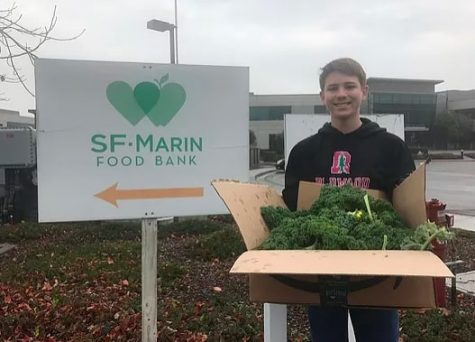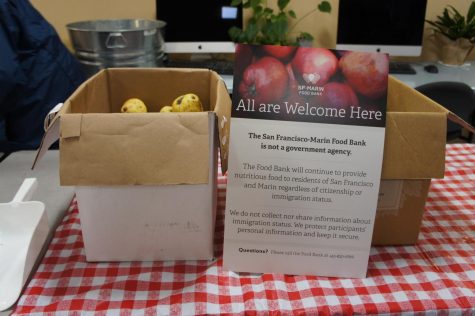Nonprofit organizations fight widespread hunger in Marin
December 11, 2018
Every Tuesday from 4 p.m. to 5:30 p.m., Marin County residents can walk inside Tiburon’s Hilarita apartment complex to find a spread of nutritious food and welcoming volunteers. The residents look through the fresh meat, produce, bread and grains that are available to choose their groceries for the week. This scene may look like a typical day in the farmers’ market, but it’s actually the work of the San Francisco-Marin Food Bank. The Hilarita “pantry” opened during the week of Aug. 27, and is the food bank’s first location in Tiburon.
Companies like the SF-Marin Food Bank work to provide food to people in need to end hunger in both San Francisco and Marin. According to Mark Seelig, spokesperson for the SF-Marin Food Bank, one in five people in Marin County experience some level of hunger issues.
“I didn’t know the scope of the hunger problem when I first started here. I was blown away by the amount of people that are hungry here. It’s the biggest problem that no one’s really talking about right now,” Seelig said.
According to Seelig, the non-profit decided to start a pantry in Tiburon after receiving a call that there were hungry elderly people in the area.
“We went out there and there were a lot of low-income seniors living there. It had the need, it had the space, it had the volunteers [we required]. People think Tiburon is a very wealthy place, but there are a lot of people who are hungry and living off of fixed incomes,” Seelig said.
While California has a median income of $67,739 and Marin County has a median income of $103,845 according to Data USA, Marin’s hunger rate is 7.5 percent higher than California’s.
Junior Jack Van Hooser and his brother, freshman Scott Van Hooser, have dedicated their time to help end some of this hunger. After noticing a significant amount of food waste from plants in their neighbors’ yards, they started an organization called Share the Bounty, which they use to collect and donate food to the SF-Marin Food Bank. Scott stated that they decided to start their nonprofit to donate under an easily recognizable name in order to raise awareness.
“We wanted to set up a portfolio for ourselves for spreading the word to help out our community. We thought, why should this all be wasted when we could be giving this to people who need it?” Scott said.
Share the Bounty’s work has helped the brothers reach out to more people for donations, and they achieved the mark of one-ton of food donated. Jack stated that he and his brother spend a little over an hour each week collecting produce.

Holding a box of fresh vegetables, founder Jack Van Hooser prepares to donate to the San Francisco Marin Food Bank.
“We market on NextDoor and people come to us saying, ‘We have this kind of fruit,’ or ‘We have this kind of vegetable, can you come to our house and pick it up?’ and we take it down to the food bank and they deal with it from there,” Jack said. “They package it up and they can give it to people who are in need of food. A lot of people reach out to us because it’s convenient, so I think it definitely helps that we’re willing to do the work for them.”
According to Jack, the nonprofit has experienced difficulties raising awareness and getting donations due to stereotypes surrounding food banks.
“Not a lot of people know that the [SF Marin] Food Bank takes fresh food. I think that when people think of donating food, they think of canned foods, and some people don’t have the time to drive down to the bank,” Jack said. “The locations also change over the years. So I think sometimes it helps to get the word out about it and then offer to take the fruit there, and pick the fruit or vegetables off the tree for them.”
Seelig has noticed a smaller proportion of visitors at the food bank as a result of some common stereotypes.
“A lot of people feel forced to come to the food bank because they can’t put food on their own table. They feel the stigma of someone who’s poor and needs charity and it’s the worst thing that could happen for us. We fight that all the time,” Seelig said.
Although these stigmas may deter people from receiving help, the food bank has attempted to adapt in order to make customers feel more comfortable. Volunteers work at the food bank center, but they can also contribute to the more widespread pantry system where people can access the food bank’s resources in a neighborhood setting with a grocery store-like arrangement.

According to Seelig, this setup gave customers more independence with their own choices compared to the previous model of being handed a bag prepared by the food bank in advance.
“It gives them an opportunity to feel like they’re actually shopping. When you go to get food and they just hand you a bag, you feel like you’re basically being told what to eat. This way, they feel like they’re actually shopping for the foods they want and they hopefully walk away feeling happy,” Seelig said.
The San Francisco-Marin Food Bank has 200 locations in San Francisco and 70 in Marin. The closest food bank to Redwood High School is located at 2 Tamalpais Dr. in Corte Madera and is open from 4 p.m. to 6 p.m. every Thursday.
For more information on the San Francisco-Marin Food Bank, visit https://www.sfmfoodbank.org/. To learn more about Share the Bounty, visit https://www.sharethebountymarin.org/.






